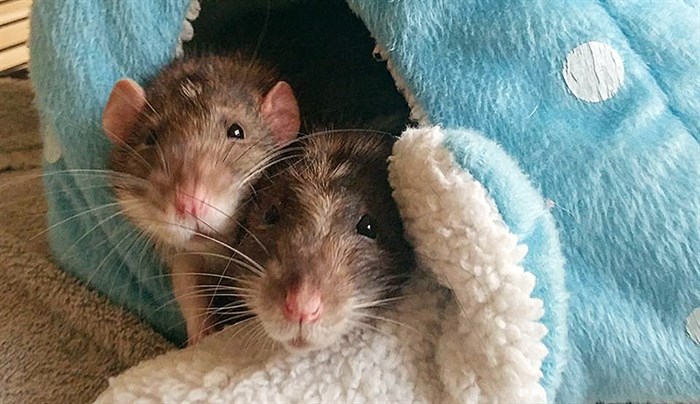
It's the year of the rat and the SPCA has some available to adopt.
Image Credit: SUBMITTED/SPCA
January 25, 2020 - 11:39 AM
Gung hay fat choi!
It's Lunar New Year today, Jan. 25, and 2020 marks the Year of the Rat.
According to the Chinese zodiac, people born in the year of the rat (birth years: 1948, 1960, 1984, 1996, 2008) are smart, resourceful, thrifty and industrious, just like rats themselves, which the SPCA has a number of.
"These smart little animals are super social and should always be kept in same-sex or neutered/spayed pairs of two or more," according to an SPCA release.
"They bond with their human guardians and enjoy being stroked or tickled. Rats can learn tricks and enjoy being challenged by toys and food puzzles in their habitat."
Domesticated or pet rats are called fancy rats and can live as long as two to three years compared to wild rats, who generally live for less than a year. There are different kinds of fancy rats, including rex, hairless, and dumbo. Fancy rats come in a range of coat colours and patterns while wild rats generally have brown fur.
10 interesting facts about rats:
-
Rats have excellent memories and will recognize their humans. Rats will affectionately nibble or lick their special person as if they were another rat.
-
Studies have shown that rats will give into peer pressure, eating unpalatable food just because their peers are doing it and they want to fit in with the group.
-
Rats are ticklish and even ‘laugh’ – emit squeaks and chirps at frequencies humans cannot hear – when having their tummy rubbed.
-
Rats can learn tricks and are thought to be as smart or smarter than dogs. Rats can be taught to come when their name is called, shake a paw or jump through a hoop. Scientists have trained rats to drive tiny cars to collect food.
-
Female rats usually have softer fur and are smaller and more active than the lazier males, who are generally more relaxed and enjoy lounging on your lap.
-
Rats enjoy playing hide-and-seek. Scientists have taught rats to play hide-and-seek. The rats showed signs that they had fun playing the game by their little “joy jumps” and by continuing to play another round instead of receiving their reward of cuddles from the researcher.
-
Rats have their own unique way of showing happiness. A rat’s eyes will boggle (bounce up and down) when they are happy and their ears will hang relaxed to the side instead of perked up.
-
Rats are empathetic and will help each other out – in one study, a rat chose to release their friend from a cage and share food with them instead of ignoring the trapped rat and chowing down.
-
Rats reproduce at a staggeringly fast pace. A single female rat can have 15,000 descendants by the end of one year. Females can have a new litter of up to 14 pups every three weeks. Spay/neuter or keep them in same-sex pairs to avoid a population explosion!
-
A group of rats is called a mischief. Male rats are called bucks, females are does, pregnant or parent rats are called dams. Newborn rats without fur are commonly referred to as pinkies. Baby rats are called pups.
Search for rats available for adoption.
To contact a reporter for this story, email Kathy Michaels or call 250-718-0428 or email the editor. You can also submit photos, videos or news tips to the newsroom and be entered to win a monthly prize draw.
We welcome your comments and opinions on our stories but play nice. We won't censor or delete comments unless they contain off-topic statements or links, unnecessary vulgarity, false facts, spam or obviously fake profiles. If you have any concerns about what you see in comments, email the editor in the link above.
News from © iNFOnews, 2020